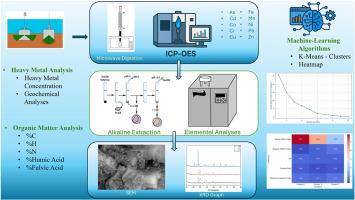基于地球化学分析和K-Means聚类的坝质沉积物可持续管理
IF 6
2区 化学
Q1 CHEMISTRY, ANALYTICAL
引用次数: 0
摘要
优化现有水坝的使用可以减少对新建筑的需求,并支持可持续的水坝管理。本研究分析了腐殖酸(HA)、黄腐酸(FA)、%C、%H、%N、总有机质(TOM)、pH、电导率和收缩/膨胀容量等关键沉积物参数。重金属浓度范围为1.62-7.74 mg/kg (As)、1.40-2.91 mg/kg (Cd)、6.79-18.44 mg/kg (Co)、19.46-85.61 mg/kg (Cr)、21.12-63.60 mg/kg (Cu)、8000-46,500 mg/kg (Fe)、260-1120 mg/kg (Mn)、27.12-180 mg/kg (Ni)、2.52-10.22 mg/kg (Pb)和30.50-88.10 mg/kg (Zn)。有机酸含量为0.050 ~ 0.88%,FA含量为0.01 ~ 1.21%。测量的pH值范围为6.99至7.92,电导率范围为0.26至4.49 mS/cm,收缩/膨胀容量范围为34.37至54.11%。使用最小-最大缩放对数据集进行归一化,以确保一致性并减少偏差。k -均值聚类应用于确定沉积物剖面,从而深入了解污染水平、土壤肥力和保持能力。将地球化学分析与基于人工智能(AI)的聚类相结合,证明了机器学习(ML)方法在基于重金属浓度的沉积物分类中的有效性。此外,扫描电镜分析揭示了不同的层状表面特征,纳米球形结构范围从100纳米到小于10纳米,为进一步了解沉积物特征和潜在的农业应用提供了进一步的见解。这项研究强调了将人工智能技术与传统分析相结合的重要性,以增强沉积物特征并促进可持续的环境管理。本文章由计算机程序翻译,如有差异,请以英文原文为准。


Integration of geochemical analysis and K-means clustering for sustainable management of various dam sediments
Optimizing the use of existing dams can reduce the need for new construction and support sustainable dam management. In this study, key sediment parameters including humic acid (HA), fulvic acid (FA), %C, %H, %N, total organic matter (TOM), pH, conductivity, and shrink/swell capacity were analyzed. Heavy metal concentrations ranged from 1.62 to 7.74 mg/kg (As), 1.40–2.91 mg/kg (Cd), 6.79–18.44 mg/kg (Co), 19.46–85.61 mg/kg (Cr), 21.12–63.60 mg/kg (Cu), 8000–46,500 mg/kg (Fe), 260–1120 mg/kg (Mn), 27.12–180 mg/kg (Ni), 2.52–10.22 mg/kg (Pb), and 30.50–88.10 mg/kg (Zn). Organic material contents were 0.050–0.88 % for HA and 0.01–1.21 % for FA. Measured pH values ranged from 6.99 to 7.92, conductivity from 0.26 to 4.49 mS/cm, and shrink/swell capacity from 34.37 to 54.11 %. The dataset was normalized using Min-Max scaling to ensure consistency and reduce bias. K-means clustering was applied to identify sediment profiles, yielding insights into pollution levels, soil fertility, and retention capacity. The integration of geochemical analysis with artificial intelligence (AI)-based clustering demonstrated the effectiveness of machine learning (ML) methods in classifying sediments based on heavy metal concentrations. Additionally, SEM analysis revealed distinct layered surface properties with nanoglobular structures ranging from 100 nm to less than 10 nm, offering further insights into the sediment characteristics and potential agricultural applications. This study underscores the importance of integrating AI techniques with traditional analyses to enhance sediment characterization and promote sustainable environmental management.
求助全文
通过发布文献求助,成功后即可免费获取论文全文。
去求助
来源期刊

Analytica Chimica Acta
化学-分析化学
CiteScore
10.40
自引率
6.50%
发文量
1081
审稿时长
38 days
期刊介绍:
Analytica Chimica Acta has an open access mirror journal Analytica Chimica Acta: X, sharing the same aims and scope, editorial team, submission system and rigorous peer review.
Analytica Chimica Acta provides a forum for the rapid publication of original research, and critical, comprehensive reviews dealing with all aspects of fundamental and applied modern analytical chemistry. The journal welcomes the submission of research papers which report studies concerning the development of new and significant analytical methodologies. In determining the suitability of submitted articles for publication, particular scrutiny will be placed on the degree of novelty and impact of the research and the extent to which it adds to the existing body of knowledge in analytical chemistry.
 求助内容:
求助内容: 应助结果提醒方式:
应助结果提醒方式:


